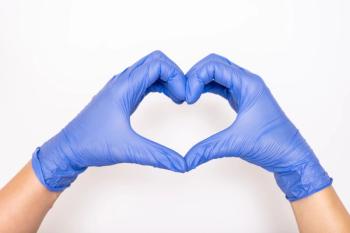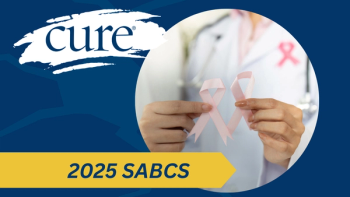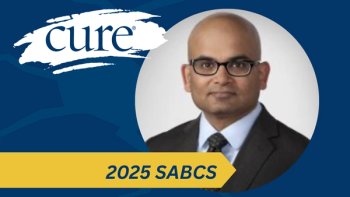
TV Anchor Amy Robach Discusses Breast Cancer Survival in Keynote Address
Breast cancer survivor and news anchor Amy Robach delivered a compelling keynote address at the 33rd Annual Miami Breast Cancer Conference® that was as hard-hitting as it was emotional.
“I have some very persuasive colleagues to thank. They pushed me past those dangerous, seductive headlines that tell young women they don’t need to be tested for breast cancer if they’re at average risk for disease.”
Breast cancer survivor and Good Morning America news anchor Amy Robach delivered a compelling keynote address at the 33rd Annual Miami Breast Cancer Conference® that was as hard-hitting as it was emotional, slamming new U.S. Preventive Services Task Force guidelines that extend the recommended age to begin mammogram screening to age 50 for women at average risk, and drawing moist eyes from the assembly of hundreds of breast cancer oncologists with her message of personal challenge and achievement.
“I thought I was that average woman in the U.S. who doesn’t have to worry about getting the breast cancer test,” Robach said describing her feelings in 2013 about mammogram screening. She was 40 years old, in excellent physical condition, and had no family history of breast cancer, leading her to believe that she was statistically in the safe zone. She had even conveniently “lost” a prescription from her OB-GYN to get a mammogram.
All those feelings of confidence and assumptions of immunity were turned upside down, she explained, when her Good Morning America producer began prodding her to take care of herself and also set an example for women aged 40 and older by getting a mammogram in the most public way: in a Times Square “mammovan” before a live television audience of 6 million.
“I guarantee you will save a life. How can you say ‘no’ to that?” Robach recalled her producer telling her. What Robach said she didn’t realize at that point was that the life she was saving would be her own. Discovery of a suspicious lump led to a stage II, node-positive breast cancer diagnosis, followed by a double mastectomy, which was her choice in order to achieve what she described as “peace of mind — to drive the potential for recurrence as far away as possible.
Her keynote drew a standing ovation from the packed room of oncologists and other healthcare professionals and was described by conference program chair Patrick I. Borgen, as the most powerful event in all 33 years of the breast cancer conference.
Robach described how she rose above the disease and found deeper appreciation for life. And for a time, the patient became the advisor to the physicians in attendance, offering, in response to their questions, advice on lobbying Washington to achieve screening recommendations for women starting at age 40; how and when to approach patients about a positive diagnosis; how to discuss with patients whether to get genetic testing; and how to prepare them for coping with the ravages of disease and treatment. Some of her strongest criticism was directed at her own news profession. Robach described having delivered some of those same headlines on screening guidelines without fully understanding the significance for that subset of women who would miss out on opportunities to catch their own breast cancer early in development.
“I have some very persuasive colleagues to thank. They pushed me past those dangerous, seductive headlines that tell young women they don’t need to be tested for breast cancer if they’re at average risk for disease. We all know that family history only predicts a small percentage of breast cancer, so I don’t buy into this average-risk security blanket that they’re pedaling.”
Her talk was at times infused with humor, as the gifted public speaker retold the events that led up to that very visible mammogram at Times Square. “My producer called me into her office and said, ‘I have a very sensitive assignment for you,’” she recalled. “’We want an anchor to have the first-ever live mammogram. We want that anchor to be you!’ I said, ‘No way, no how … I’m not going to do it. What’s next, a pap smear? These are really personal things. I don’t want 6 million people watching me have a mammogram for the first time.’”
When she got the news that they’d found something suspicious on her image, she still dragged her feet about getting it checked out.
“I wasn’t worried, I was annoyed. I remember the arguments against 40-year-olds getting mammograms: false alarms, unnecessary tests, undue anxiety. And I thought, ‘here we go. This is exactly what they’re talking about, and now I’m experiencing it. Wow.’”
But she told her mother, who latched on and “started a daily barrage of texts: have you made your appointment? Have you made your appointment?” Her mother then got her dad to text her about following up, and her dad got her brother to text her. “That pretty much made me make the phone call.”




